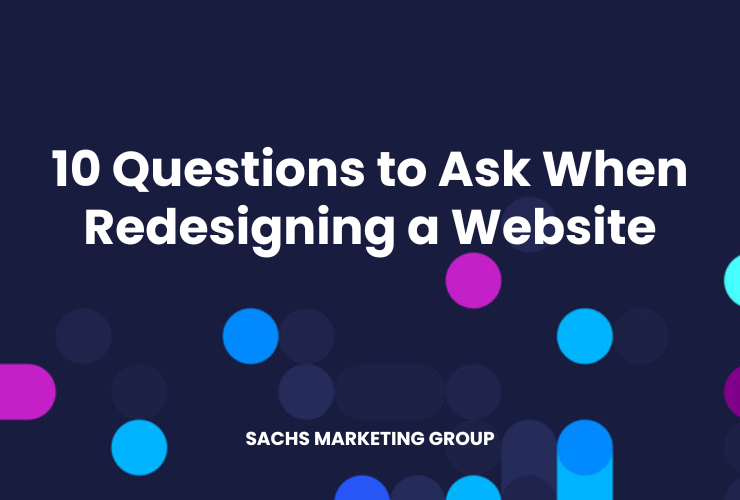There are several questions to ask when redesigning a website that will help you align the project with your business goals, enhance user experience, and ensure you get a return on investment. Ignoring these questions could result in a poorly executed redesign, costing both time and money.
Website redesigns can be overwhelming, given the myriad of components that need careful consideration.
The lack of a well-defined roadmap can derail even the most promising projects, leading to wasted resources and lost opportunities. But, fear not! A strategic approach that starts by asking the right questions can save you from these pitfalls and guide you toward a successful redesign.
In this article, we’re sharing several questions to ask when redesigning a website.
Overview
Questions to Ask When Redesigning a Website
Before you plunge into the intricacies of redesigning a website, it’s essential to plan and establish your objectives. The questions you ask now will guide the entire redesign process.
Here are 10 questions to ask when redesigning a website …
1. What is the Primary Goal of the Redesign?
Before you even start thinking about aesthetics or new features, it’s crucial to establish the primary goal of your website redesign. Are you aiming for higher visitor engagement, increased sales, or perhaps better search engine rankings? Each goal will dictate different design elements, content strategies, and functionalities.
For example, if your aim is to increase online sales by 20% in the next quarter, you’ll likely focus on optimizing product pages, implementing effective calls-to-action (CTAs), and simplifying the checkout process. On the other hand, if the goal is to build brand awareness, then a storytelling approach may be more appropriate, possibly focusing on enriching content like blogs and video testimonials.
Understanding your primary goal is foundational because it serves as the yardstick against which you can measure the success of the redesign. If everyone involved in the project knows what the primary goal is, you’ll have a unified vision guiding all decision-making processes.
2. Who is Your Target Audience?
Understanding your target audience is another pivotal aspect of any successful website redesign. Who are the people you aim to reach? What are their pain points, needs, and preferences? The more precisely you can answer these questions, the more tailored your website will be to meet the expectations of those who matter the most—your prospective customers or clients.
Consider conducting audience research through surveys, user interviews, or data analytics to gather insights into your target audience’s behavior. Pay close attention to demographic factors like age, gender, and location, but also delve into psychographics, such as interests, lifestyle, and values. This information will not only help you in the design phase, with elements like color choice and layout, but also in crafting content that resonates with your audience, ultimately leading to higher engagement and conversion rates.
3. What is Your Budget and Timeline?
While it might seem straightforward, establishing a clear budget and timeline is often overlooked, leading to scope creep and unexpected costs. Lay out a detailed budget that accounts for everything from the cost of a design agency or freelance designers, to potential expenses for new images, fonts, or any premium plugins you might need.
In the same vein, set a realistic timeline for the project, building in adequate time for revisions and unexpected delays. Are you launching a new product or service that the redesigned website needs to support? If so, work backward from the launch date to ensure the website will be ready. Make sure to communicate these constraints with all team members, including any external contractors or agencies, to keep everyone aligned and accountable.
By setting the financial and time parameters in which your redesign project needs to operate, you create a framework that helps you make informed decisions throughout the process. It might be tempting to add in a “nice-to-have” feature, but if it’s not in the budget or would substantially delay the timeline, knowing these constraints upfront allows you to prioritize effectively.
4. What Are Your Key Performance Indicators (KPIs)?
Key Performance Indicators (KPIs) serve as the metrics by which you’ll measure the success of your website redesign. These could range from lead generation and conversion rates to user engagement metrics like average session duration or page views per visit. Establishing KPIs gives you a focused set of objectives to aim for, guiding the project’s trajectory while providing a means of evaluating its success post-launch.
For instance, if one of your KPIs is to reduce the website’s bounce rate, you might focus on improving user experience through faster load times and more intuitive navigation. If increasing email sign-ups is a goal, the design team could prioritize creating compelling CTAs and opt-in forms. Remember to regularly review these KPIs post-launch to measure performance and make data-driven adjustments.
5. What Content Needs Updating or Adding?
Content is often the linchpin that holds your website together and engages your audience. Therefore, it’s crucial to assess what content needs updating, revising, or adding entirely during the redesign process. This is the time to remove outdated information, enhance existing content for SEO, and incorporate new material that aligns with your brand message and goals.
For example, if you have a blog, take the opportunity to prune posts that no longer align with your brand or that offer little value. Add new articles that resonate with your target audience. Similarly, review and update product descriptions, testimonials, and FAQs. If new services or features are being introduced, make sure to create content that fully explains their benefits and functionalities.
6. Is the Current Technology Stack Adequate?
Evaluating your technology stack is an essential yet often overlooked step in a website redesign. Your website’s backend technologies should be robust enough to support your new design and features while also being scalable for future updates. This means taking a close look at your CMS (Content Management System), databases, hosting services, and any APIs or third-party tools that your website utilizes.
If your current CMS makes it difficult to implement desired features or is cumbersome to use, consider migrating to a platform better suited to your needs. Assess whether the existing plugins or third-party services are still serving their purpose effectively or if newer, more powerful alternatives are available. Keep an eye on compatibility issues, as new designs or features might not play well with older technologies.
By ensuring that your technology stack can support both your immediate redesign goals and future growth, you’re laying a strong foundation for a website that’s not just visually appealing but also functionally robust.
7. What Features Do You Want to Add?
A website redesign provides an ideal opportunity to add new features that enhance user experience and deliver more value to your audience. Whether it’s incorporating an e-commerce functionality, adding a blog section, or creating interactive elements like quizzes or calculators, you need to clearly define what features are necessary to achieve your primary goals.
For instance, if improving user engagement is a priority, features like chat support or a community forum could be beneficial. If you’re an e-commerce site looking to boost sales, consider adding product recommendation engines or quick-checkout options. These additions should align not only with your redesign’s goals but also the needs and preferences of your target audience.
Remember, every feature you add should be driven by a clearly defined purpose, so it integrates seamlessly with the overall strategy, enhancing the website’s effectiveness and not cluttering it.
8. How Will You Optimize for Mobile Users?
Optimizing for mobile is non-negotiable in today’s digital landscape, where a significant percentage of users access websites via smartphones and tablets. During the redesign process, mobile optimization should be a top priority, ensuring that the site provides a smooth and user-friendly experience across various devices.
One common approach is to adopt a responsive design, where the website automatically adjusts its layout depending on the screen size. Test the mobile version for loading speed, as mobile users often have less patience for slow-loading sites. Pay close attention to navigation, as well. Menus and CTA buttons should be easily accessible, and text should be readable without requiring zoom.
If you’re an e-commerce business, optimizing for mobile also means making sure the checkout process is as streamlined as possible to reduce cart abandonment rates on smaller screens.
By putting mobile optimization at the forefront of your redesign strategy, you’re not only catering to a wide audience but also positively impacting your search engine rankings, as Google increasingly factors mobile experience into its algorithms.
9. What Security Measures Need Implementation?
Security should be a top concern when redesigning a website, especially if you deal with sensitive user data or conduct transactions. Failing to implement proper security measures could lead to data breaches, legal issues, and loss of customer trust. Consider features like SSL certificates for encrypted data transfer, firewalls, and secure coding practices to protect against SQL injections and cross-site scripting (XSS) attacks.
If your website will handle financial transactions, compliance with Payment Card Industry (PCI) standards is mandatory. Two-factor authentication (2FA) or multi-factor authentication (MFA) could add an additional layer of security for admin access. Consult with a cybersecurity expert to conduct a vulnerability assessment and recommend tailored security measures that fit your website’s specific needs.
10. Who Will Maintain the Website Post-Launch?
Once your redesigned website is live, the work doesn’t end. Regular updates, security monitoring, and performance optimizations are ongoing tasks that require dedicated effort. Consider whether your in-house team has the capacity and expertise to manage this, or if outsourcing to a specialized agency would be more efficient.
If you opt for in-house management, make sure the team is well-versed in the technology stack you’re using and trained to handle any potential issues. Regularly updating content, reviewing SEO performance, and monitoring KPIs should be part of the routine.
If you choose to outsource, look for agencies that offer comprehensive maintenance packages, including regular updates, 24/7 monitoring, and quick response times for issues. Having a reliable team to handle post-launch maintenance can free you to focus on strategic tasks like marketing and business development.
By establishing a clear maintenance plan as part of your redesign strategy, you ensure that your website remains secure, functional, and effective in the long run.
Redesign Your Website with Sachs Marketing Group
Is your website in need of a redesign? Sachs Marketing Group is here to help.
Imagine having a redesigned website that not only looks visually stunning but also performs exceptionally, driving more traffic and conversions. Sachs Marketing Group has the design experience needed to work with you to design a new website that not only refreshes your brand but also supports your business.
Contact us today to ensure your website redesign is a resounding success.
Conclusion
Asking the right questions when redesigning a website can be the difference between its success and failure. These questions ensure you cover all your bases, from understanding your audience to optimizing for mobile and security.
Whether you’re going it alone or thinking about hiring professionals, being prepared is your first step to a successful website redesign.
Contact us today to get the conversation started!












